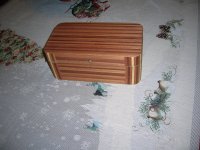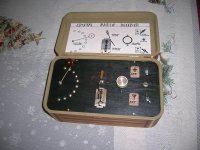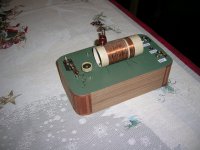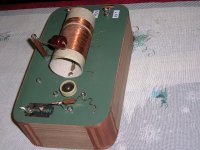Looks like these really should be an easy DIY project with results equal to or superior to the commercial offering!
No, purely advertising.
Did you actually pull any and test them? Two recent gadgets had fake advertising features and no one seems to care. Both a solar powered calculator and one of those shake to recharge flashlights had coin cells hidden in them. The solar cell was a piece of plastic and the "generator' in the flashlight had a slug of metal instead of a neo magnet. Late 50's and early 60's transistors were not particularly cheap, I have a hard time believing the unused ones were 100% to spec, the yield to noise for instance was abysmal.
I have a complete KLH stereo system with the turntable and loudspeakers, if you are interested!
thanks... but
</sarcasm>
Did you actually pull any and test them? Two recent gadgets had fake advertising features and no one seems to care. Both a solar powered calculator and one of those shake to recharge flashlights had coin cells hidden in them. The solar cell was a piece of plastic and the "generator' in the flashlight had a slug of metal instead of a neo magnet. Late 50's and early 60's transistors were not particularly cheap, I have a hard time believing the unused ones were 100% to spec, the yield to noise for instance was abysmal.
Yes the sharp folks tested and graded all their transistors to use them where best. So the dummies probably were the worst if even functional.
In my youth a VTVM was about my limit of test equipment. So testing transistors for other than diode action wasn't on my list of capabilities.
I have seen "three way" loudspeakers where there were no wires to the "tweeter" wires to the midrange terminal strip but no voice coil. Not surprisingly there was no crossover.
So what do you expect from folks who stuff in unused parts to increas advettising claims?
Here are two zero-transistor radios from the hands of a promising diyer youngster (there is still hope 🙂)I have a 7 Transistor radio.
George
Attachments
Here are two zero-transistor radios from the hands of a promising diyer youngster (there is still hope 🙂)
George
Looks like that engineer doesn't need the razor blades yet anyway. 🙂
Yes. He is not in need to shave a beard yet 😀
But he knows how to surface-oxidize the razor blade for the purpose
George
But he knows how to surface-oxidize the razor blade for the purpose
George
Yeah but magnets allow for a better story. The magnetic field will force the electrons inside the opamp to follow curved trajectories, and thus will eliminate the glare and treble harshness produced by sharp turns.

I thought the magnets went on your ears, to cover them, thus eliminating the awful sound.
Hi Fi earplugs here:
https://www.etymotic.com/consumer/hearing-protection/er20.html
😀
Small magnets in ears are being used to receive electro-magnetic field from a necklace loop. Mono, unfortunately!
Edit: Here you go, https://www.amazon.com/Bluetooth-Earpiece-Neckloop-Amplifier-Invisible/dp/B00NVROTQA
Edit: Here you go, https://www.amazon.com/Bluetooth-Earpiece-Neckloop-Amplifier-Invisible/dp/B00NVROTQA
Last edited:
The original post was "what is wrong with OP-amps?". In 2016 (and probably in 1997~2016) the answer is "nothing".
Selected and designed carefully = piece of wire with gain.
If you want tube effects, buy tubes. If you want no effect, buy OP-amps. If you want touchy-feely vinyl, buy vinyl. But use OP-amps in the pre-amp 🙂
Selected and designed carefully = piece of wire with gain.
If you want tube effects, buy tubes. If you want no effect, buy OP-amps. If you want touchy-feely vinyl, buy vinyl. But use OP-amps in the pre-amp 🙂
Last edited:
Selected and designed carefully = piece of wire with gain.
With small gain. The more, the worse. 🙂
Sometimes it is better to use a couple of opamp stages with low gain than one stage with high gain.
With small gain. The more, the worse. 🙂
Sometimes it is better to use a couple of opamp stages with low gain than one stage with high gain.
Or a composite, which get exponentially easier to stabilize at higher gain. Then again, outside of mics and phono preamps, when do we deal with high gain in audio? Even the multi-KW power amps of the world are around a G = 50.
Or a composite, which get exponentially easier to stabilize at higher gain. Then again, outside of mics and phono preamps, when do we deal with high gain in audio? Even the multi-KW power amps of the world are around a G = 50.
That's why microphone, phono, and power amps are an alloy of science and art.
Or a composite, which get exponentially easier to stabilize at higher gain. Then again, outside of mics and phono preamps, when do we deal with high gain in audio? Even the multi-KW power amps of the world are around a G = 50.
Tone controls.
As usual, the most incompetent designers completely circumvented the issue, invoking "purism" and eliminating them altogether.
What Tone Control has high gain? By high gain, I'm talking roughly G >= 100; that'd be one heck of an adjustment. A gain of even 10 isn't that much at all.
Tone controls.
As usual, the most incompetent designers completely circumvented the issue, invoking "purism" and eliminating them altogether.
Haven't used them in years, always sound like an "effect" to me.😀 Anyways keeps jerk guests from turning up the bass all the way, any party always has one.
The original post was "what is wrong with OP-amps?". In 2016 (and probably in 1997~2016) the answer is "nothing".
Selected and designed carefully = piece of wire with gain.
If you want tube effects, buy tubes. If you want no effect, buy OP-amps. If you want touchy-feely vinyl, buy vinyl. But use OP-amps in the pre-amp 🙂
From an entirely simplistic point of view, guess that is a reasonable point of view.
Please define "selected"?
And also "designed carefully"? Is that the opamp or the circuit?
I need to know, so that I and others reading along know what and how to do it.
_-_-bear
- Status
- Not open for further replies.
- Home
- General Interest
- Everything Else
- What is wrong with op-amps?





